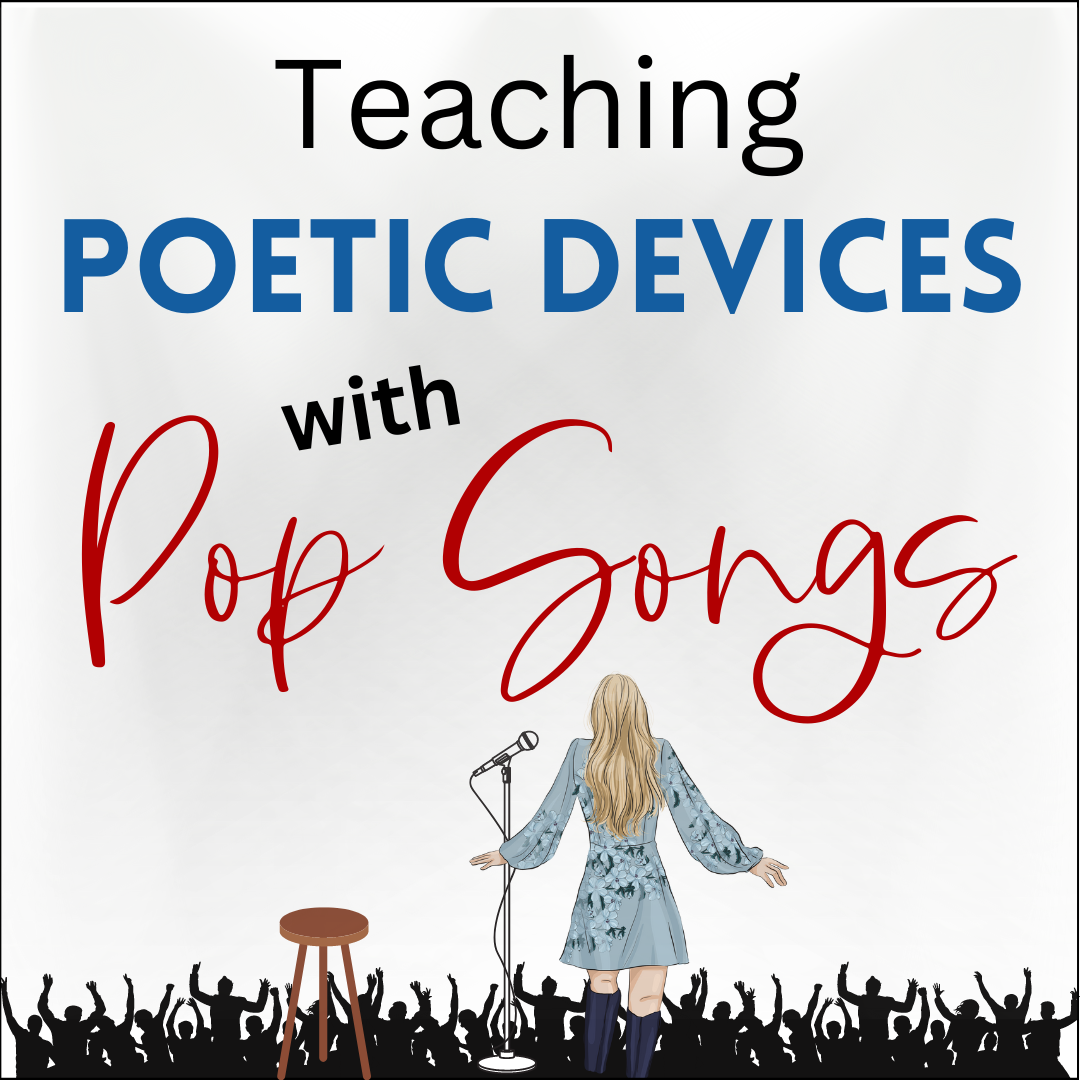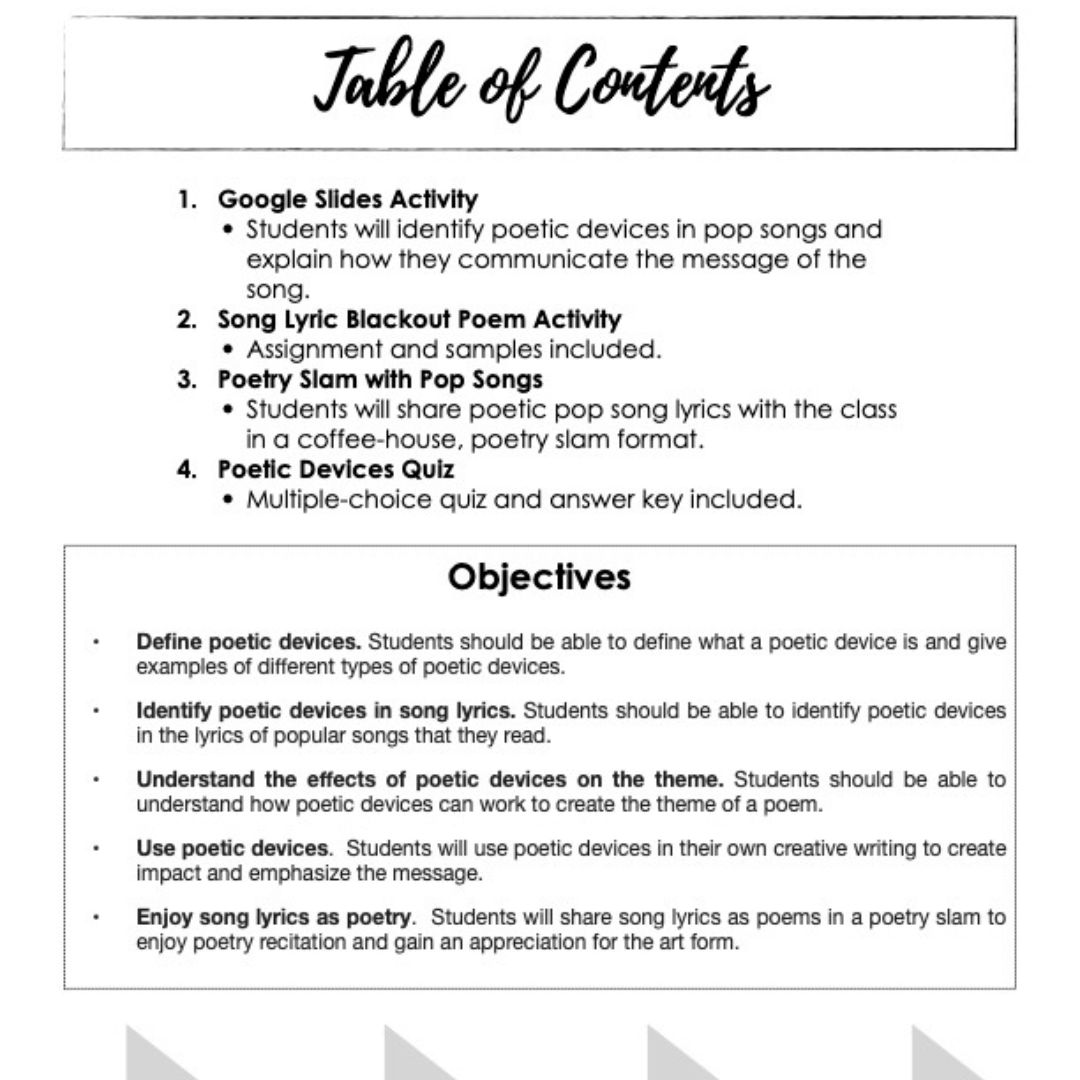Teaching poetic devices with pop songs can be a fun and engaging way to help students learn about poetry. It can also help them to appreciate the beauty and complexity of language.
Here are some ideas on how to teach poetic devices with pop songs in English class:
Start with a familiar song. Choose a song that your students are familiar with and that has a clear message. Play the song for the class and have them listen to the lyrics. Then, ask them to identify any poetic devices that they hear. You can provide a list of common poetic devices to help them get started.
Analyze the lyrics. Once students have identified some poetic devices, have them analyze how the devices are used in the song. What effect do they have on the meaning of the song? How do they create a mood or atmosphere?
Compare and contrast songs. Once students have a good understanding of how poetic devices are used in one song, you can have them compare and contrast two or more songs. How are the poetic devices used differently in each song? What effect does this have on the meaning of the song?
Write their own songs. As a culminating activity, you can have students write their own songs using poetic devices. This will give them a chance to practice using the devices they have learned about and to create their own unique works of art.
Here are some additional tips for teaching poetic devices with pop songs:
Make it fun. Use songs that your students enjoy and that will keep them engaged.
Keep it simple. Start with basic poetic devices and gradually introduce more complex ones as students become more comfortable.
Provide examples. Give students examples of how poetic devices are used in songs. You can do this by playing songs for them, showing them videos, or providing handouts.
Have students practice. Give students opportunities to practice identifying and using poetic devices in songs. This can be done in class, as homework, or as part of a project.
Be patient. It takes time for students to learn about and understand poetic devices. Be patient and provide them with the support they need to succeed.
Check out the Bespoke ELA Poetic Devices with Pop Songs Bundle here!
Check out these other song titles as options for teaching poetic devices in your ELA classes.
Song Options
Here are some pop songs that can be used to teach poetic devices:
"All Too Well" by Taylor Swift uses imagery, metaphor, and assonance to tell the story of a relationship that has ended.
"Bohemian Rhapsody" by Queen uses alliteration, assonance, and consonance to create a powerful and dramatic song.
"Hallelujah" by Leonard Cohen uses imagery, metaphor, and simile to explore the themes of love, loss, and faith.
"Imagine" by John Lennon uses imagery, metaphor, and personification to create a hopeful vision of a world without war or poverty.
"Perfect" by Ed Sheeran uses imagery, metaphor, and simile to describe a perfect love.
"Rolling in the Deep" by Adele uses imagery, metaphor, and simile to describe a heartbreak.
"The Sound of Silence" by Simon & Garfunkel uses imagery, metaphor, and personification to describe a world that is increasingly disconnected and lonely.
"Viva la Vida" by Coldplay uses imagery, metaphor, and simile to describe the rise and fall of a king.
"I'm Like a Bird" by Nelly Furtado uses simile and metaphor to compare the singer to a bird.
"Firework" by Katy Perry uses metaphor to compare the singer to a firework.
"Love Yourself" by Justin Bieber uses repetition and assonance to create a powerful message about self-love.
"Bad Guy" by Billie Eilish uses alliteration and assonance to create a dark and edgy sound.
"Hope is a Dangerous Thing for a Woman to Have - but I Have It" by Lana Del Rey uses allusion and symbolism to create a complex and layered song.
"Hey Jude" by The Beatles uses repetition and assonance to create a comforting and hopeful song.
"Sing" by Ed Sheeran uses alliteration and assonance to create a catchy and uplifting song.
"Story of My Life" by One Direction uses metaphor and simile to tell a personal and relatable story.
"The Sound of Silence" by Simon & Garfunkel uses imagery and symbolism to create a haunting and thought-provoking song.
"Can't Stop the Feeling!" by Justin Timberlake uses alliteration and assonance to create a catchy and fun song.
"Don't Stop Believin'" by Journey uses repetition and assonance to create a powerful anthem of hope and perseverance.
"Love Yourself" by Justin Bieber uses repetition and assonance to create a powerful message about self-love.
"Shake It Off" by Taylor Swift uses alliteration and assonance to create a catchy and fun song about overcoming haters.
“Thinking Out Loud” by Ed Sheeran uses vivid imagery to depict his never-ending love for his partner.
“Blank Space” by Taylor Swift uses metaphors to create a sense of danger and excitement, comparing the singer to a nightmare in a relationship.
“Teardrops on my Guitar” by Taylor Swift uses personification to create a sense of sadness and loneliness.
“Anti-hero” by Taylor Swift uses clever and distinct contrasts to depict the singer’s sense of wanting to face the pressures of being famous and the toll it can take on one’s mental health.
“Roar” by Katy Perry uses metaphors and similes to depict her strength to face hardships and overcome them.
“Stronger” by Kelly Clarkson uses a metaphor to describe her resilience and growth after facing hardship.
“Better Together” by Luke Combs uses similes and metaphors to describe a strong relationship and how life is literally “better together.”
“Count on me” by Bruno Mars uses a ton of figurative language such as simile, metaphor, personification, hyperbole, repetition, and alliteration to convey a message about how you can always count on friends and family.
“Empire State of Mind” by Jay-Z and Alicia Keys uses alliteration, personification, repetition, simile, metaphor, and other devices to portray an ode-like appreciation of New York City.
“Diamonds” by Rihanna uses alliteration, assonance, and metaphor to compare herself to a diamond, a symbol of strength and beauty.
“Stay” by Rihanna uses repetition, assonance, and metaphor to suggest that the singer is drawn to her lover even though she knows that it is not a good relationship.
“God’s Plan” (clean version) by Drake uses alliteration, assonance, and personification to show that money is a powerful force that can control people's lives.
“Love you Like a Love Song” by Selena Gomez uses alliteration, assonance, and metaphor to compare her love to a "love song."
“Lose You to Love me” by Selena Gomez uses several devices such as repetition, anaphora, epistrophe, imagery, personification, and more to create a powerful and emotional song about heartbreak and self-discovery.
“Bad Romance” by Lady Gaga uses alliteration, assonance, metaphor, personification, imagery, and more to create a powerful and memorable song about love, sex, and money.
“Zero” by Imagine Dragons uses alliteration, assonance, simile, imagery, personification, and repetition to create a powerful and inspiring song about overcoming adversity and achieving one's dreams.
These are just a few examples of pop songs that can be used to teach poetic devices. There are many other songs that could be used, so feel free to explore and find songs that you think would be appropriate for your students.
Feel free to share more in the comments!
Related Resource
About the Author
Meredith is the founder and creator of Bespoke ELA and TeachWriting.org. She has taught high school English for 15+ years in Dallas, Chicago, and New York City and holds a M.A. in Literature from Northwestern University. She has always had a connection to the written word-- through songwriting, screenplay writing, and essay writing-- and she enjoys the process of teaching students how to express their ideas. Meredith enjoys life with her sweet daughter and Yorkie.







